

Compact Muon Solenoid
LHC, CERN
| CMS-HIN-18-019 ; CERN-EP-2022-164 | ||
| First measurement of the forward rapidity gap distribution in pPb collisions at $ \sqrt{\smash[b]{s_{_{\mathrm{NN}}}}} = $ 8.16 TeV | ||
| CMS Collaboration | ||
| 18 January 2023 | ||
| Phys. Rev. D 108 (2023) 092004 | ||
| Abstract: For the first time at LHC energies, the forward rapidity gap spectra from proton-lead collisions for both proton and lead dissociation processes are presented. The analysis is performed over 10.4 units of pseudorapidity at a center-of-mass energy per nucleon pair of $ \sqrt{\smash[b]{s_{_{\mathrm{NN}}}}} = $ 8.16 TeV, almost 300 times higher than in previous measurements of diffractive production in proton-nucleus collisions. For lead dissociation processes, which correspond to the pomeron-lead event topology, the EPOS-LHC generator predictions are a factor of two below the data, but the model gives a reasonable description of the rapidity gap spectrum shape. For the pomeron-proton topology, the EPOS-LHC, QGSJET II, and HIJING predictions are all at least a factor of five lower than the data. The latter effect might be explained by a significant contribution of ultra-peripheral photoproduction events mimicking the signature of diffractive processes. These data may be of significant help in understanding the high energy limit of quantum chromodynamics and for modeling cosmic ray air showers. | ||
| Links: e-print arXiv:2301.07630 [hep-ex] (PDF) ; CDS record ; inSPIRE record ; HepData record ; CADI line (restricted) ; | ||
| Figures | |

png pdf |
Figure 1:
Topologies of $\mathrm{pPb}$ events with large FRG for $ \mathbb{P}\text{Pb} $ (left) and $ \mathbb{P}\mathrm{p} $ or $ \gamma\mathrm{p} $ (right). The blue and red cones indicate the products of diffractive dissociation for the lead ion and proton, respectively. The regions free of final-state particles are marked with green arrows. It is possible for $ \gamma\text{Pb} $ interactions to mimic the topology on the left but these are highly suppressed compared to the $ \gamma\mathrm{p} $ case on the right. |
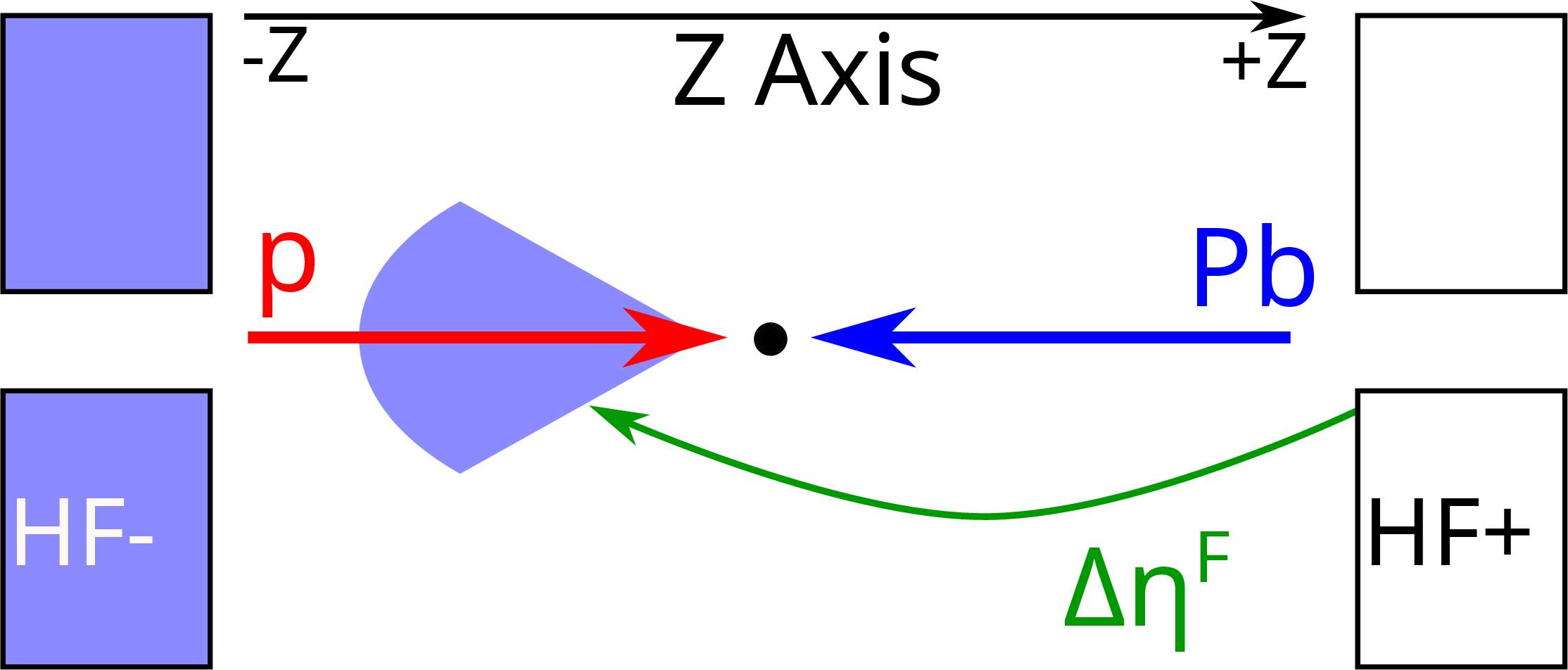
png pdf |
Figure 1-a:
Topology of $\mathrm{pPb}$ events with large FRG for $ \mathbb{P}\text{Pb} $. The blue cone indicates the products of diffractive dissociation for the lead ion. proton. The region free of final-state particles is marked with green arrows. |

png pdf |
Figure 1-b:
Diagram of $\mathrm{pPb}$ events with large FRG for $ \mathbb{P}\text{Pb} $. |
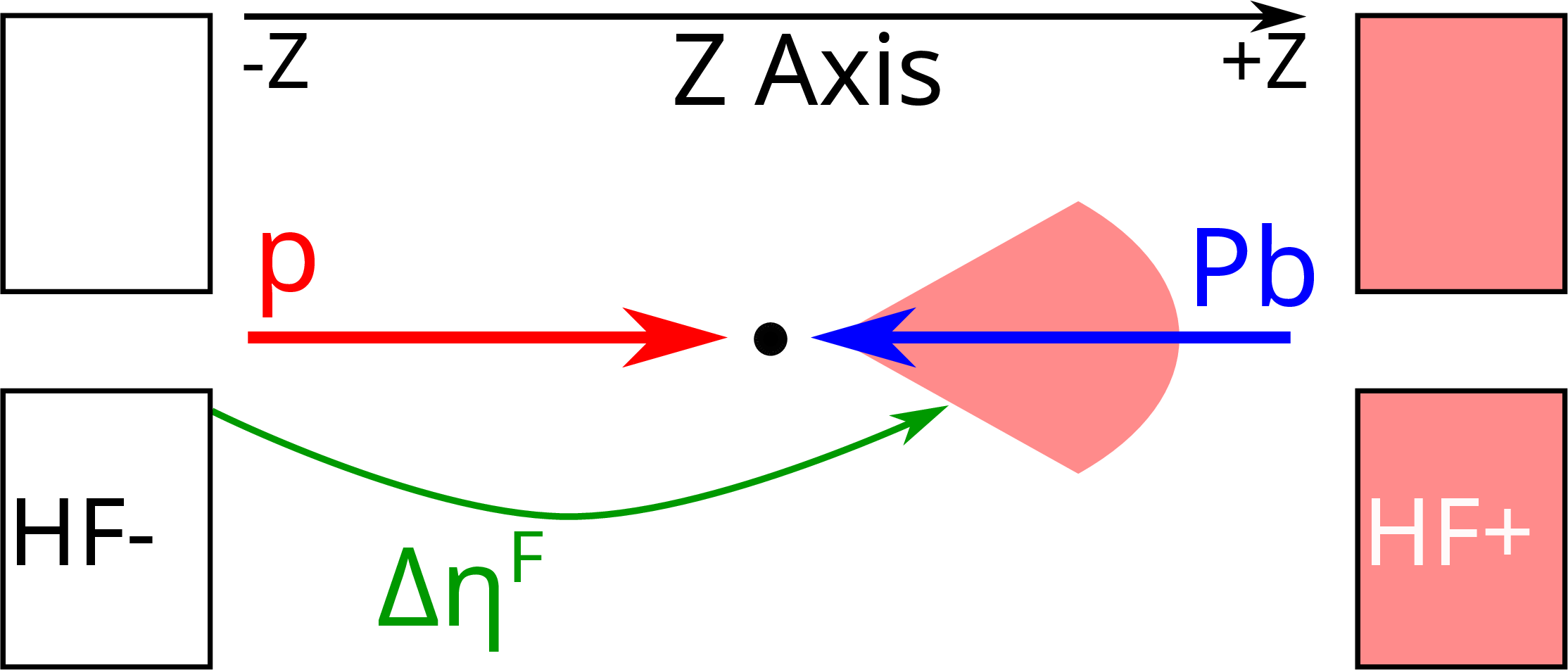
png pdf |
Figure 1-c:
Topology of $\mathrm{pPb}$ events with large FRG for $ \mathbb{P}\mathrm{p} $ or $ \gamma\mathrm{p} $. The red cone indicates the products of diffractive dissociation for the lead ion. proton. The region free of final-state particles is marked with green arrows. |
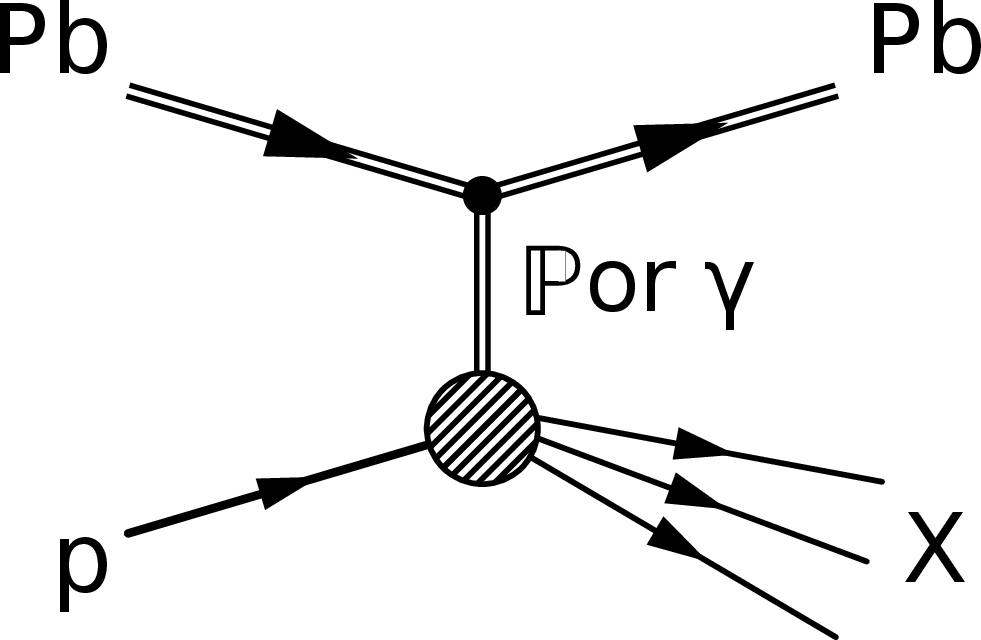
png pdf |
Figure 1-d:
Diagram of $\mathrm{pPb}$ events with large FRG for $ \mathbb{P}\mathrm{p} $ or $ \gamma\mathrm{p} $. |

png pdf |
Figure 2:
Differential cross section $ \mathrm{d} \sigma / \mathrm{d} \Delta\eta^{\text{F}} $ for events with $ \mathbb{P}\text{Pb} $ (left) and $ \mathbb{P}\mathrm{p} $+$ \gamma\mathrm{p} $ (right) topologies obtained at the reconstruction level for $ |\eta| < $ 3.0 region. Also shown are the simulated predictions of EPOS-LHC (blue) and HIJING (green). The statistical and systematic errors are added in quadrature and shown with the gray band. The simulated spectra are normalized to the total visible cross section of the data. The bottom panels show the ratio of simulated predictions to data. |
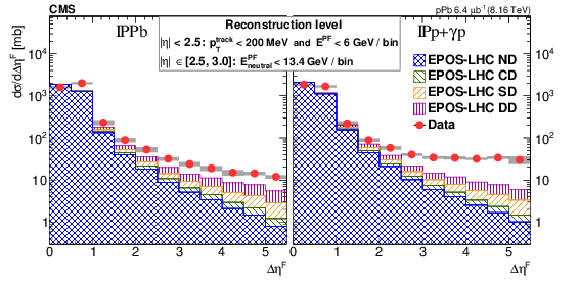
png pdf |
Figure 3:
Reconstruction level $ \mathrm{d} \sigma / \mathrm{d} \Delta\eta^{\text{F}} $ spectra obtained for the central acceptance, $ |\eta| < $ 3, for the $ \mathbb{P}\text{Pb} $ (left) and $ \mathbb{P}\mathrm{p} $+$ \gamma\mathrm{p} $ (right) topologies and compared to the corresponding EPOS-LHC predictions. The EPOS-LHC predictions are broken down into the nondiffractive (ND, blue), central-diffractive (CD, green), single-diffractive (SD, orange) and double-diffractive (DD, purple) components, shown as stacked contributions. |
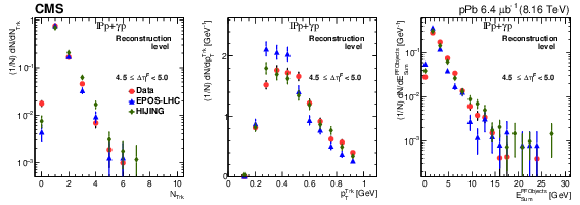
png pdf |
Figure 4:
The number of high purity tracks, $ N_{\mathrm{Trk}} $ (left), their transverse momentum, $ p_{\mathrm{T}} $, (middle), and the total energy of all PF candidates, $ E^{\text{PFObjects}}_{\text{Sum}} $, (right) in the first $ \eta $ bin after a gap of 4.5 $ < \Delta\eta^{\text{F}} < $ 5.0, for events with the $ \mathbb{P}\mathrm{p} $+$ \gamma\mathrm{p} $ topology. Also shown are the corresponding distributions for the EPOS-LHC and HIJING generators. |
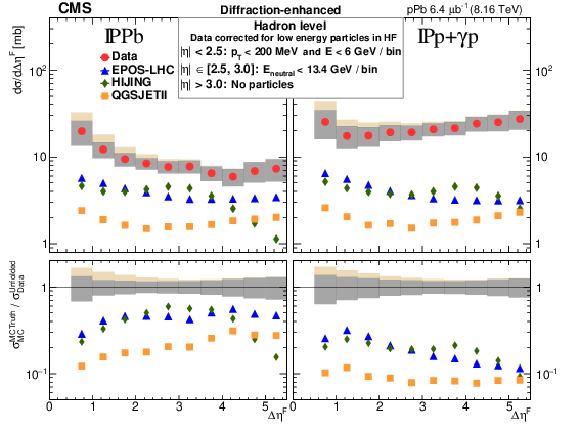
png pdf |
Figure 5:
Unfolded diffraction-enhanced differential cross section $ \mathrm{d} \sigma / \mathrm{d} \Delta\eta^{\text{F}} $ spectra compared to hadron level predictions of the EPOS-LHC, HIJING, and QGSJET II generators. The data are corrected for the contribution from events with undetectable energy in the HF calorimeter adjacent to the FRG. The corrections are obtained using the EPOS-LHC MC samples. For the $\mathrm{pPb}$ data sample, in the $ \mathbb{P}\text{Pb} $ case (left), the FRG, $ \Delta\eta^{\text{F}} $, is measured from $ \eta = $ 3 and no particles are present within 3.00 $ < \eta < $ 5.19, while for the $ \mathbb{P}\mathrm{p} $+$ \gamma\mathrm{p} $ case (right), the FRG is measured from $ \eta = - $ 3 and no particles are present within $ -5.19 < \eta < - $ 3.00. The statistical and systematic uncertainties are added in quadrature. The gray band shows the resulting uncertainty. The yellow band indicates the values of the only MC-based correction done to account for the HF calorimeter energy deposition below the noise level. The bottom panels show the ratio of the predictions of the three generators to data. |
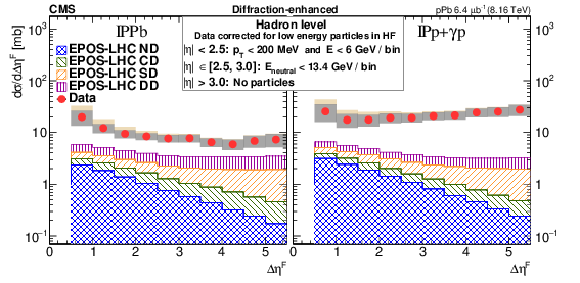
png pdf |
Figure 6:
Unfolded diffraction-enhanced differential cross section $ \mathrm{d} \sigma / \mathrm{d} \Delta\eta^{\text{F}} $ spectra for the $ \mathbb{P}\text{Pb} $ (left) and $ \mathbb{P}\mathrm{p} $+$ \gamma\mathrm{p} $ (right) topologies compared to the EPOS-LHC predictions. The EPOS-LHC predictions are broken down into the nondiffractive (ND, blue), central-diffractive (CD, green), single-diffractive (SD, orange) and double-diffractive (DD, purple) components, shown as stacked contributions. |
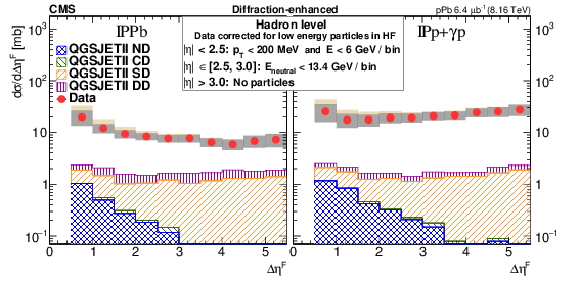
png pdf |
Figure 7:
Unfolded diffraction-enhanced differential cross section $ \mathrm{d} \sigma / \mathrm{d} \Delta\eta^{\text{F}} $ spectra for the $ \mathbb{P}\text{Pb} $ (left) and $ \mathbb{P}\mathrm{p} $+$ \gamma\mathrm{p} $ (right) topologies compared to the QGSJET II predictions. The QGSJET II predictions are broken down into the nondiffractive (ND, blue), central-diffractive (CD, green), single-diffractive (SD, orange) and double-diffractive (DD, purple) components, shown as stacked contributions. |
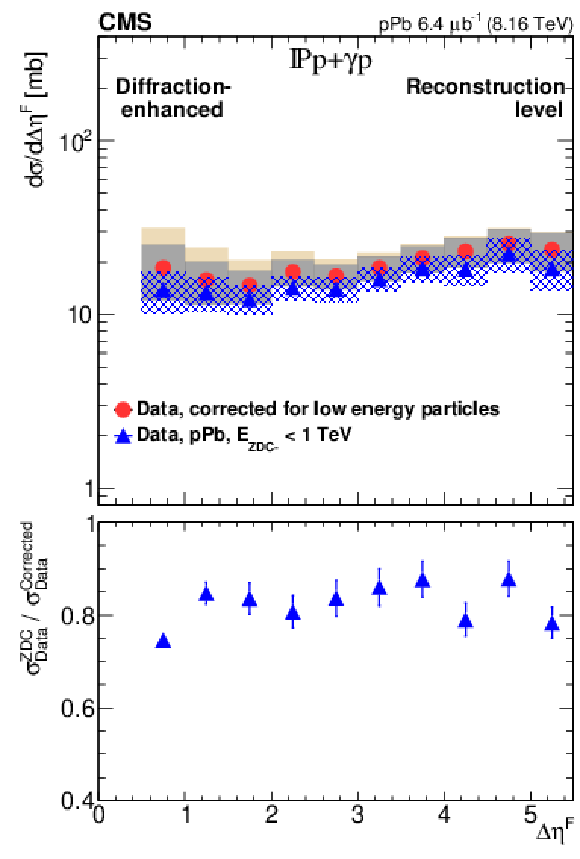
png pdf |
Figure 8:
Top: Reconstruction level diffraction-enhanced differential cross section $ \mathrm{d} \sigma / \mathrm{d} \Delta\eta^{\text{F}} $ spectrum corrected for the contribution from events with undetectable energy in the HF calorimeter adjacent to the rapidity gap. The correction value is indicated with the yellow band. The statistical and systematic uncertainties are added in quadrature. The gray band shows the resulting uncertainty. The distribution is shown together with the spectrum obtained with events satisfying the ZDC veto requirement $ E_{\mathrm{ZDC-}} < $ 1 TeV which selects only the events without lead nuclear break up. No correction for HF undetectable energy is applied to this distribution and no systematic uncertainties related to the ZDC veto are accounted for. The statistical and systematic uncertainties are added in quadrature. Bottom: A fraction of events selected with the ZDC veto requirement as a function of the rapidity gap size. Only statistical uncertainties are shown in the plot. |
| Summary |
| For the first time at the CERN LHC, the forward rapidity gap spectra $ \mathrm{d} \sigma / \mathrm{d} \Delta\eta^{\text{F}} $ for proton-lead (pPb) collisions at a center-of-mass energy per nucleon pair of $ \sqrt{\smash[b]{s_{_{\mathrm{NN}}}}} = $ 8.16 TeV have been measured for both pomeron-lead ($ \mathbb{P}\text{Pb} $) and pomeron-proton ($ \mathbb{P}\mathrm{p} $+$ \gamma\mathrm{p} $) topologies. For the latter topology, predictions from the EPOS-LHC, QGSJET II, and HIJING generators are a factor of five or more below the data for large rapidity gaps. This suggests a very strong contribution from $ \gamma\mathrm{p} $ interactions, which are not included in these event generators. For the $ \mathbb{P}\text{Pb} $ topology, where the photon-exchange contribution is expected to be negligible, the EPOS-LHC predictions are about a factor of 2 and the QGSJET II predictions are about a factor of 4 below the data. However, the shape of the $ \mathrm{d} \sigma / \mathrm{d} \Delta\eta^{\text{F}} $ spectrum is similar to that in data for both these generators. In contrast to the data, HIJING demonstrates a sharp decline for large rapidity gaps. These results will be helpful to understand the high energy limit of quantum chromodynamics and in modeling cosmic ray air showers. |
| References | ||||
| 1 | V. N. Gribov | Possible asymptotic behavior of elastic scattering | JETP Lett. 41 (1961) 667 | |
| 2 | G. F. Chew and S. C. Frautschi | Principle of equivalence for all strongly interacting particles within the S-matrix framework | PRL 7 (1961) 394 | |
| 3 | F. E. Low | A model of the bare pomeron | PRD 12 (1975) 163 | |
| 4 | S. Nussinov | Colored quark version of some hadronic puzzles | PRL 34 (1975) 1286 | |
| 5 | V. S. Fadin, E. A. Kuraev, and L. N. Lipatov | On the Pomeranchuk singularity in asymptotically free theories | PLB 60 (1975) 50 | |
| 6 | A. B. Kaidalov | Diffractive production mechanisms | Phys. Rept. 50 (1979) 157 | |
| 7 | A. Donnachie and P. V. Landshoff | Elastic scattering and diffraction dissociation | NPB 244 (1984) 322 | |
| 8 | LHC Forward Physics Working Group Collaboration | LHC Forward Physics | JPG 43 (2016) 110201 | 1611.05079 |
| 9 | V. N. Gribov | Glauber corrections and the interaction between high-energy hadrons and nuclei | Sov. Phys. JETP 29 (1969) 483 | |
| 10 | R. J. Glauber | High-energy collision theory | in Lectures in theoretical physics, W.E. Brittin and L.G. Dunham, eds., volume 1, Interscience Publishers, New York, 1959 | |
| 11 | B. Z. Kopeliovich, L. I. Lapidus, and A. B. Zamolodchikov | Dynamics of color in hadron diffraction on nuclei | JETP Lett. 33 (1981) 595 | |
| 12 | B. Z. Kopeliovich, I. K. Potashnikova, and I. Schmidt | Large rapidity gap processes in proton-nucleus collisions | Phys. Rev. C 73 (2006) 034901 | hep-ph/0508277 |
| 13 | HELIOS Collaboration | Diffraction dissociation of nuclei in 450 GeV/$ c $ proton-nucleus collisions | Z. Phys. C 49 (1991) 355 | |
| 14 | EHS/NA22 Collaboration | Reactions with leading hadrons in meson-proton interactions at 250 GeV/$ c $ | Z. Phys. C 75 (1997) 229 | |
| 15 | A. B. Kaidalov, V. A. Khoze, A. D. Martin, and M. G. Ryskin | Diffraction of protons and nuclei at high-energies | Acta Phys. Polon. B 34 (2003) 3163 | hep-ph/0303111 |
| 16 | L. Frankfurt and M. Strikman | Novel QCD phenomena in pA collisions at LHC | in 2nd Workshop on Hard Probes in Heavy Ion Collisions at the LHC: 2nd Plenary Meeting Geneva, 2002 March 1 (2002) 1 |
hep-ph/0210088 |
| 17 | V. Guzey and M. Strikman | Proton-nucleus scattering and cross section fluctuations at RHIC and LHC | PLB 633 (2006) 245 | hep-ph/0505088 |
| 18 | W.-T. Deng, X.-N. Wang, and R. Xu | Hadron production in p+p, p+Pb, and Pb+Pb collisions with the HIJING 2.0 model at energies available at the CERN Large Hadron Collider | Phys. Rev. C 83 (2011) 014915 | 1008.1841 |
| 19 | T. Pierog et al. | EPOS LHC: Test of collective hadronization with data measured at the CERN Large Hadron Collider | Phys. Rev. C 92 (2015) 034906 | 1306.0121 |
| 20 | S. Ostapchenko | Monte Carlo treatment of hadronic interactions in enhanced Pomeron scheme: I. QGSJET-II model | PRD 83 (2011) 014018 | 1010.1869 |
| 21 | V. Barone and E. Predazzi | High-energy particle diffraction | volume 565 of Texts and Monographs in Physics, Springer-Verlag, Berlin Heidelberg, ISBN~978-3-540-42107-8, 2002 | |
| 22 | ATLAS Collaboration | Rapidity gap cross sections measured with the ATLAS detector in pp collisions at $ \sqrt{s}= $ 7 TeV | EPJC 72 (2012) 1926 | 1201.2808 |
| 23 | CMS Collaboration | Measurement of diffraction dissociation cross sections in pp collisions at $ \sqrt{s}= $ 7 TeV | PRD 92 (2015) 012003 | 1503.08689 |
| 24 | A. J. Baltz et al. | The physics of ultraperipheral collisions at the LHC | Phys. Rept. 458 (2008) 1 | 0706.3356 |
| 25 | R. Luna, A. Zepeda, C. A. Garcia Canal, and S. J. Sciutto | Influence of diffractive interactions on cosmic ray air showers | PRD 70 (2004) 114034 | hep-ph/0408303 |
| 26 | S. Ostapchenko | LHC data on inelastic diffraction and uncertainties in the predictions for longitudinal extensive air shower development | PRD 89 (2014) 074009 | 1402.5084 |
| 27 | V. N. Gribov | A reggeon diagram technique | Sov. Phys. JETP 53 (1967) 654 | |
| 28 | T. Sjöstrand and M. van Zijl | A multiple interaction model for the event structure in hadron collisions | PRD 36 (1987) 2019 | |
| 29 | CMS Collaboration | HEPData record for this analysis | link | |
| 30 | CMS Collaboration | Performance of the CMS Level-1 trigger in proton-proton collisions at $ \sqrt{s}= $ 13 TeV | JINST 15 (2020) P10017 | CMS-TRG-17-001 2006.10165 |
| 31 | CMS Collaboration | The CMS trigger system | JINST 12 (2017) P01020 | CMS-TRG-12-001 1609.02366 |
| 32 | CMS Collaboration | The CMS experiment at the CERN LHC | JINST 3 (2008) S08004 | |
| 33 | CMS Collaboration | Particle-flow reconstruction and global event description with the CMS detector | JINST 12 (2017) P10003 | CMS-PRF-14-001 1706.04965 |
| 34 | GEANT4 Collaboration | GEANT 4---a simulation toolkit | NIM A 506 (2003) 250 | |
| 35 | CMS Collaboration | CMS luminosity measurement using 2016 proton-nucleus collisions at nucleon-nucleon center-of-mass energy of 8.16 TeV | CMS Physics Analysis Summary, 2018 CMS-PAS-LUM-17-002 |
CMS-PAS-LUM-17-002 |
| 36 | CMS Collaboration | Description and performance of track and primary-vertex reconstruction with the CMS tracker | JINST 9 (2014) P10009 | CMS-TRK-11-001 1405.6569 |
| 37 | CMS Collaboration | Coherent $ \mathrm{J}/\psi $ photoproduction in ultra-peripheral PbPb collisions at $ \sqrt{\smash[b]{s_{_{\mathrm{NN}}}}}= $ 2.76 TeV with the CMS experiment | PLB 772 (2017) 489 | CMS-HIN-12-009 1605.06966 |
| 38 | CMS Collaboration | Measurement of exclusive $ \rho(770)^0 $ photoproduction in ultraperipheral pPb collisions at $ \sqrt{\smash[b]{s_{_{\mathrm{NN}}}}}= $ 5.02 TeV | EPJC 79 (2019) 702 | CMS-FSQ-16-007 1902.01339 |
| 39 | CMS Collaboration | Measurement of exclusive $ \Upsilon $ photoproduction from protons in pPb collisions at $ \sqrt{\smash[b]{s_{_{\mathrm{NN}}}}}= $ 5.02 TeV | EPJC 79 (2019) 277 | CMS-FSQ-13-009 1809.11080 |
| 40 | CMS Collaboration | Evidence for light-by-light scattering and searches for axion-like particles in ultraperipheral PbPb collisions at $ \sqrt{\smash[b]{s_{_{\mathrm{NN}}}}}= $ 5.02 TeV | PLB 797 (2019) 134826 | CMS-FSQ-16-012 1810.04602 |
| 41 | CMS Collaboration | Charged-particle nuclear modification factors in PbPb and pPb collisions at $ \sqrt{\smash[b]{s_{_{\mathrm{NN}}}}}= $ 5.02 TeV | JHEP 04 (2017) 039 | CMS-HIN-15-015 1611.01664 |
| 42 | CMS Collaboration | Calibration of the CMS hadron calorimeters using proton-proton collision data at $ \sqrt{s}= $ 13 TeV | JINST 15 (2020) P05002 | CMS-PRF-18-001 1910.00079 |
| 43 | G. D'Agostini | A multidimensional unfolding method based on Bayes' theorem | NIM A 362 (1995) 487 | |
| 44 | T. Adye | Unfolding algorithms and tests using RooUnfold | in Proceedings, Workshop on Statistical Issues Related to Discovery Claims in Search Experiments and Unfolding, 2011 PHYSTAT 2011 (2011) 313 |
1105.1160 |
| 45 | S. Schmitt | Data unfolding methods in high energy physics | in EPJ Web Conf. XIIth Quark Confinement and the Hadron Spectrum, volume 137, 2017 link |
1611.01927 |
| 46 | O. Surànyi | Performance of the CMS Zero Degree Calorimeters in the 2016 pPb run | J. Phys. Conf. Ser. 1162 (2019) 012005 | |
| 47 | O. Surànyi et al. | Performance of the CMS Zero Degree Calorimeters in pPb collisions at the LHC | JINST 16 (2021) P05008 | 2102.06640 |

|
Compact Muon Solenoid LHC, CERN |

|

|

|

|

|

|